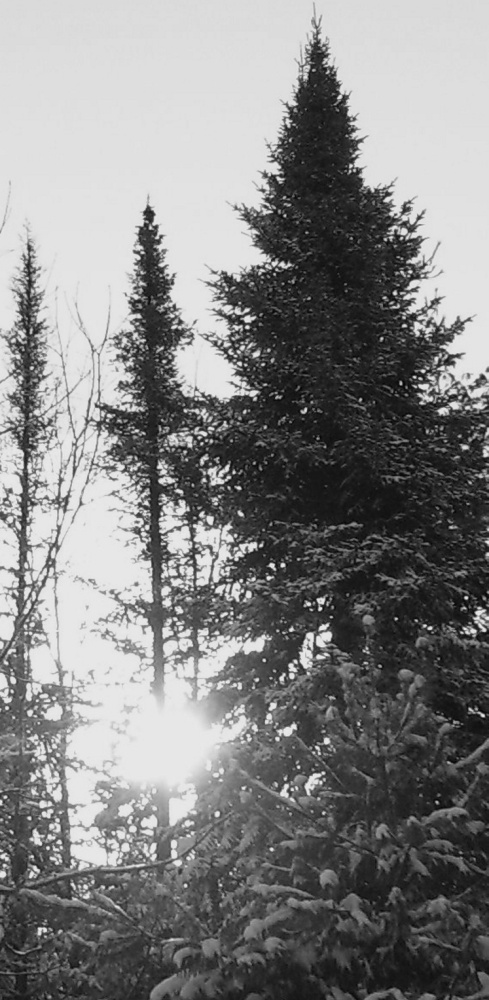Along about the first of this month, with Christmas lurking just around the corner, I went for a usual late-morning walk up the road. No snow yet. Pickup trucks traveling past at roughly two-thirds the speed of light. Bite in the air, but no wind. Maples, birches, oaks and elms bare and gray. Scudding clouds. The fields of the horse farm dingy with December. Beautiful, actually. Except for the vehicles.
It was getting on toward noon, but fir and spruce shadows littered the pavement. Through the skeletal woods you could see the glow where the sun was nearly as high as it was going to get. Tomorrow, it would not get quite that high, and the next day not as high as that. And so on into the month. To Dec. 21, to be precise.
I looked at it too long, and the mottle out of the woods started playing tricks on the mind’s eye. Almost midday, this was, and shadows splayed over the blue-gray road in the angles of summer evenings. Was it day or was it dusk, there in the morning of December?
Why this should be disturbing, I didn’t know. But it was kind of haunting and bewildering, the sense of initial lostness you daydream might come when you’re finally on the threshold of expiring. Or across it. What must ancient people have felt when the sun for all the world was sinking, day by chilly winter day?
Because I, of course, had no-nonsense science to fall back on. I rehearsed it in my mind as I walked and trucks blew by, and soon the unmistakable fear and trembling that was lurking in the sunlight behind the trees dispersed. Just to rehearse it again: The sun over the course of 365 days appears to rise through springtime higher and higher in the sky to its highest point in the latter part of June, and then descend through fall lower and lower in the sky to its lowest point in the latter part of December. The pattern repeats exactly the next year, and the next, on into seeming eternity.
This is quite a strange phenomenon, when you dwell on it. Shadowy. But mechanically explicable. The Earth orbits the sun once every 365¼ days. It’s tilted on its axis, meaning the North Pole and South Pole are not straight up and down with respect to the sun, but tipped at an angle of about 23.5 degrees. In the part of the orbit when the North Pole tips toward the sun, the sun appears to climb higher in the sky and stays up longer — summer. When the North Pole tips away, the sun appears lower in the sky each day and sets sooner — winter. (The Southern Hemisphere’s seasons are opposite ours.) So this tilt, combined with the Earth’s orbital motion, changes the altitude of the sun — as we see it — over the course of the year. It reaches its highest point around June 21 and its lowest point around Dec. 21.
If you lived 2,000 years ago, you had no access to these mechanical facts, although some ancient astronomers did have an inkling that even though it looks for all the world like the sun circles the Earth, the opposite might actually be true. But in the ancient everyday, you had this mysterious annual phenomenon of the sun climbing up the sky and then descending down, year in and year out. Whose lengthening shadows can seem strange in a December morning chill.
Your everyday knowledge of natural phenomena would be scientifically null but personally alive. The world was by and large experienced as a living activity then, however strange it seemed. A much different experience from the inert, objective clockwork our minds have learned to eye in about the past 500 years. When you noticed the sun lower in the sky, you had the direct experience of it in the feeling of strangeness, mysteriousness. Instead of numbing your fear with a mental diagram of orbital mechanics, your way of talking about it was to tell a story: The sun like everything else in the universe is a living being, retreating in fall to leave us in the cold, and returning in the spring to warm the fields and crops and people. Forever.
Scientists usually call this story an “explanation,” as though it was a misguided scientific hypothesis about a mechanical process. But that’s not what it was. It was an evocation of the feeling that connects you to the phenomenon: the gigantic awe, mystery and strangeness the yearlong rise and fall of the sun inspires in sentient beings. “The sky is just the same as the Earth, only up above, and older,” goes a translation of an ancient Micmac story.
Sun god stories still affect people today, in their many mythological manifestations. Because even though we now know how sky mechanics work, that sense of strangeness and awe, if you pay attention to the shadows, still exists. We are still human.
I don’t mean science is wrong, of course, or uninspiring. I mean it is one side of a coin with at least four dimensions. The imaginations that visualized the motions and mathematics of the Earth and planets revolving around the sun were prodigious. If you don’t think so, try it yourself. Start with the practically undeniable observation that the sun rises in the east, moves slowly across the sky and then sets in the west every day. Clearly, to your own repeated witness, the sun circles around the Earth. How would I — who still sees an M.C. Escher drawing every time I open the hood of my car — ever figure out it’s the Earth that’s moving around the sun?
You can see why the emphasis in ancient times was on the feeling you got when summer evening shadows plastered the horse track on middays in winter. It was a feeling of prodigious invisible power and strangeness. It was direct knowledge that the sun would flawlessly return. It was a sign of your own place in eternity. Where you too would return.
Scientifically, it is pretty sure — almost as sure as the Earth circling the sun — that Jesus was born in March. But your connection to him is his promise of the god’s return; so really, the truth inside the story is that his real birthday is toward the end of December.
I throw this out there as a suggestion from the edge of a December morning.
Dana Wilde lives in Troy. You can contact him at naturalist1@dwildepress.net. His recent book is “Summer to Fall: Notes and Numina from the Maine Woods” available from North Country Press. <http://www.northcountrypress.com/summer-to-fall.html> Backyard Naturalist appears the second and fourth Thursdays each month.
Success. Please wait for the page to reload. If the page does not reload within 5 seconds, please refresh the page.
Enter your email and password to access comments.
Invalid username/password.
Please check your email to confirm and complete your registration.
Only subscribers are eligible to post comments. Please subscribe or login first for digital access. Here’s why.
Use the form below to reset your password. When you've submitted your account email, we will send an email with a reset code.
Send questions/comments to the editors.




Related